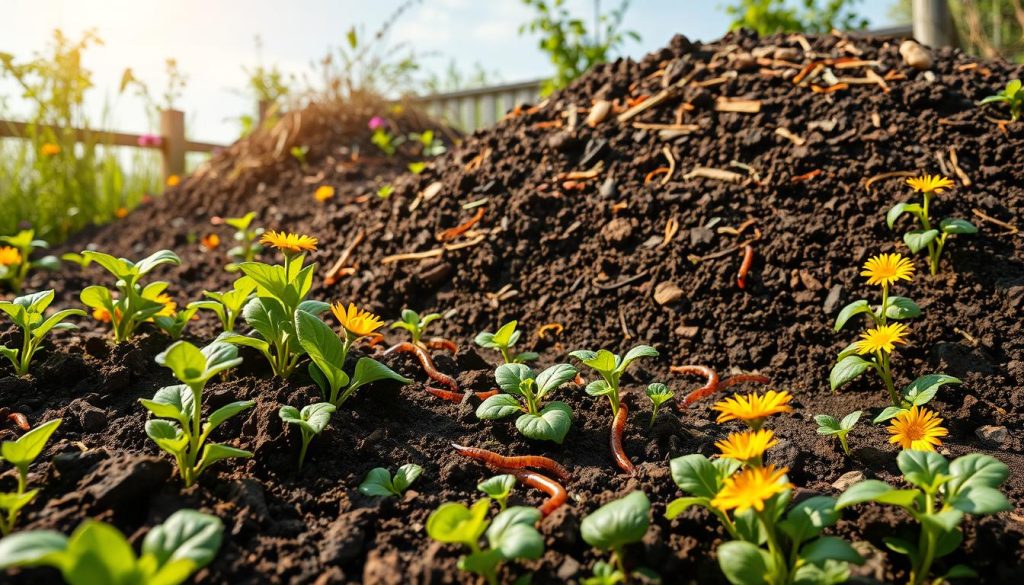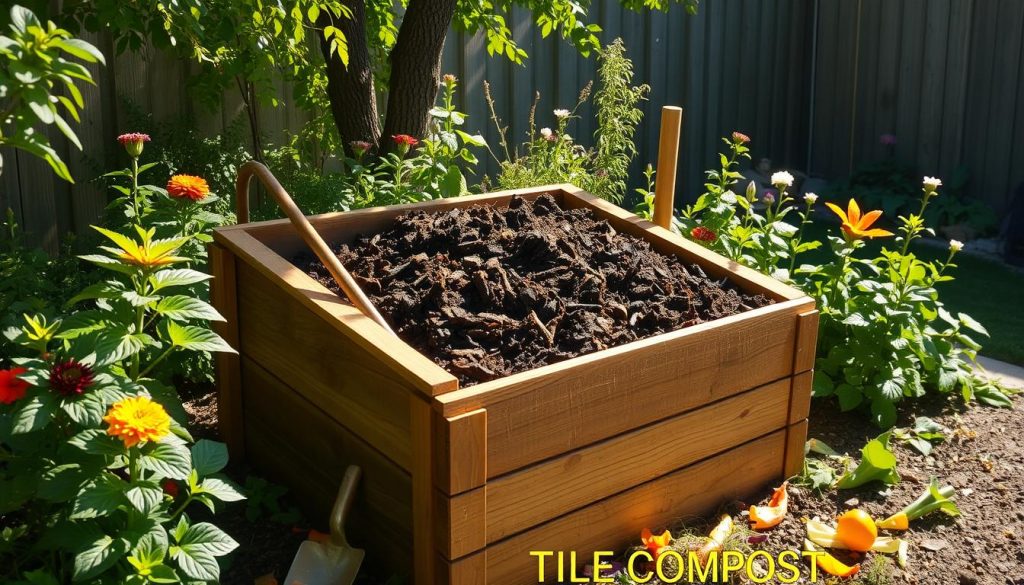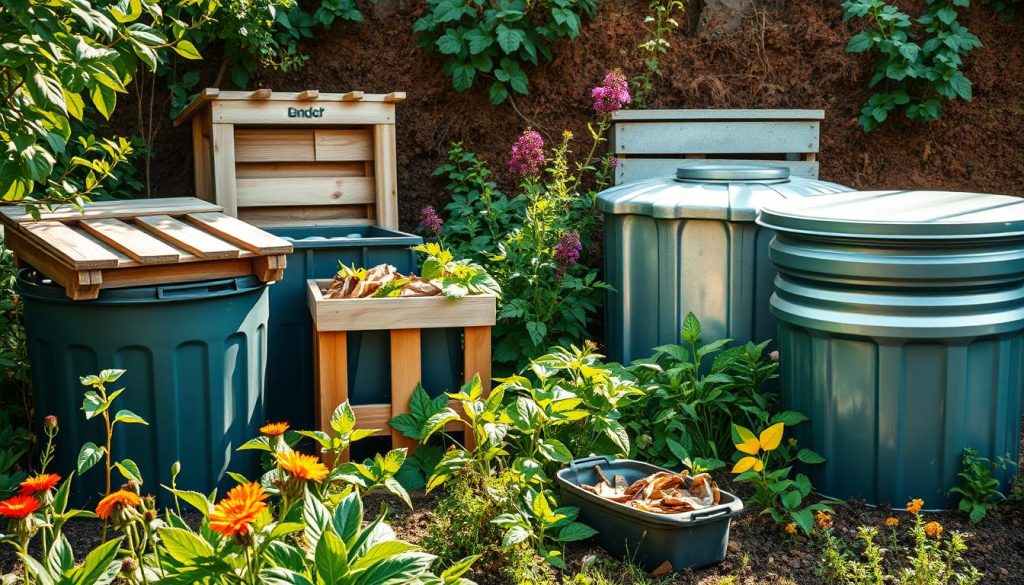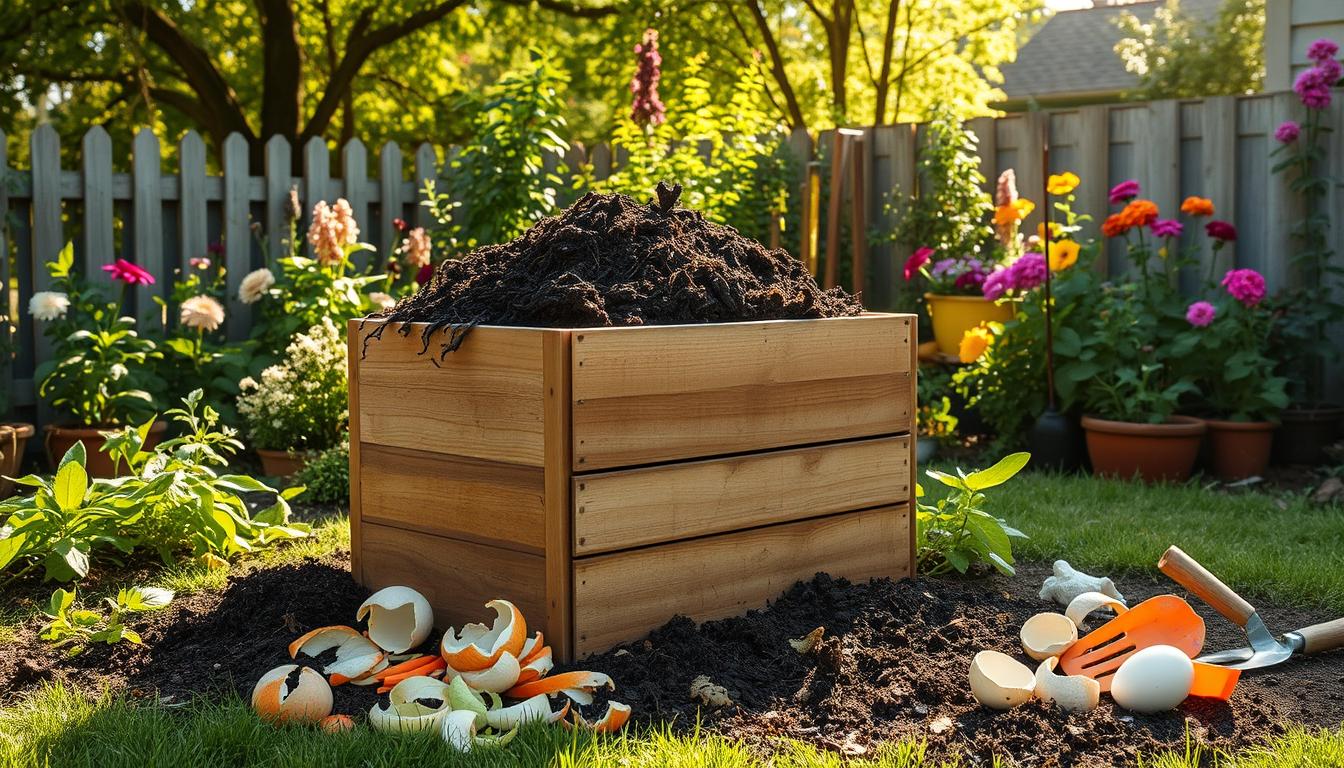I’m excited to share the basics of composting with you. We’ll go through a step-by-step guide on starting a compost bin. Composting helps reduce waste and makes your garden soil better. It’s a great way to live more sustainably.
Starting to compost might seem hard, but it’s really simple. First, you need to know why composting is good for your garden. This guide will teach you everything about composting. Soon, you’ll be composting like a pro.
In this guide, we’ll talk about composting basics. We’ll cover how to start a bin, what to compost, and how to keep it going. By the end, you’ll know how to compost and enjoy its benefits.
Understanding Composting: Why It Matters
Composting is a great way to help our planet. It reduces waste and makes a valuable resource for gardens. It’s also good for the environment. When you start a compost pile, knowing the best methods is key.
Composting helps the environment a lot. It cuts down on greenhouse gases and saves water. It’s a simple way to make a big difference. Some main benefits include:
- Reduced greenhouse gas emissions
- Conservation of water
- Creation of a valuable resource for gardens
Setting up a compost pile needs the right spot and methods. You need to mix green and brown materials, keep it moist, and turn it often. These steps help make a compost pile that’s good for your garden.

The Benefits of Composting
Composting has many benefits. It reduces waste and makes a great resource for gardens. It’s good for the environment and improves your soil’s health.
Environmental Impact
Composting has a big impact on the environment. It can cut down on greenhouse gases and save water. By composting, we reduce landfill waste and fight climate change.
Reducing Waste in Landfills
Composting is a big help in reducing landfill waste. This is crucial for fighting climate change. By composting, we make our planet more sustainable.
Choosing the Right Location for My Compost Bin
Choosing the right spot for my compost bin is key. It should be easy to get to for upkeep. This helps me keep the compost fresh and effective.
Think about sunlight and shade. Some sun helps, but too much dries it out. Too little slows it down. I aim for a spot that gets just the right amount.
Sunlight and Shade Considerations
To find the perfect spot, I can try a few things:
- Look for a place that gets some sun but also has shade, like under a tree.
- Choose a bin with a lid to control how much sun gets in.
- Make sure to mix “green” and “brown” materials to keep it moist.
Accessibility for Maintenance
It’s also smart to put the bin near my kitchen. This makes adding scraps easy. It also lets me check on the compost often. This way, I can make sure it’s working well and helping the environment.

Selecting the Perfect Compost Bin
Choosing the right compost bin is key when starting a backyard compost. A step-by-step guide can help you make this choice. With many options, picking the best one can be tough.
Different Types of Compost Bins
There are many compost bins to choose from. You can pick from wooden pallet bins, wire mesh bins, or plastic bins. Each has its own pros and cons, depending on what you need.
Factors to Consider
When picking a compost bin, think about size, material, and ventilation. A bigger bin might be needed for lots of yard waste. A smaller bin works for smaller yards. The bin’s material also matters, as some are more durable.
DIY Options vs. Store-Bought Bins
If you’re good with your hands, making your own compost bin is a great idea. It’s cheaper and you can make it fit your needs. But, store-bought bins are easy to put together and convenient. Your choice depends on what you prefer and your skills.

By looking at these factors and options, you can find the perfect compost bin. Then, you can start your composting journey with confidence.
What to Compost: Ingredients That Work
Starting a green compost bin requires knowing what to add. It’s key to mix green and brown materials for a healthy compost. Green materials like food scraps and grass clippings are rich in nitrogen. Brown materials, such as leaves and twigs, are high in carbon.
Here are some good ingredients for your compost bin:
- Green materials: fruit and vegetable peels, tea bags, and coffee grounds
- Brown materials: dried leaves, shredded newspaper, and small twigs
When starting, avoid adding meat, dairy, and pet waste. These can attract pests and cause bad smells. By following these tips and balancing your materials, you’ll make nutrient-rich compost for your garden.
Keep an eye on your compost’s moisture and turn it often for best results. With patience and practice, your compost will help your garden grow strong. You’ll see the benefits of your green compost bin efforts soon.
Maintaining My Compost Bin
Starting to compost can be exciting, but keeping your bin in good shape is key. It makes sure your compost is top-notch. Regular care helps your bin work well and fast.
Composting is not just fun; it’s also rewarding. With the right steps, you can make great soil for your garden. For example, turning the compost often helps it break down faster.
- Turning the compost every 7-10 days to ensure adequate aeration
- Monitoring moisture levels to maintain a consistent balance
- Adding a mix of green and brown materials to create a balanced compost
By following these tips, you can make your compost bin thrive. This way, you’ll get great compost for your garden.
Troubleshooting Common Composting Issues
As I continue on my composting journey, I’ve faced some common issues. These can be frustrating, but they’re easily fixed with the right techniques. By using the best composting methods and practicing organic waste recycling, I’ve overcome these challenges. Now, my compost bin is thriving.
One common issue is odors and pests. I’ve found that the right mix of materials can solve this. Adding dry leaves, grass clippings, and food scraps helps get rid of bad smells. It also attracts beneficial insects.
Addressing Odors and Pests
- Balance green and brown materials to eliminate odors
- Add dry leaves or grass clippings to absorb excess moisture
- Turn the compost pile regularly to introduce oxygen and speed up decomposition
Another issue I’ve seen is temperature imbalances. This can slow down decomposition. By monitoring the temperature and adding materials as needed, I’ve kept the temperature right. This creates a healthy compost environment.
Fixing Temperature Imbalances
By following these tips and using the best composting methods, I’ve fixed common composting issues. Organic waste recycling has not only reduced my waste. It’s also given me a nutrient-rich soil amendment for my garden.
Using Finished Compost in My Garden
When your compost is ready, it’s time to use it in your garden. First, screen and harvest the compost. This makes it easy to apply. Just sift it through a mesh screen to get rid of big pieces. What’s left is the nutrient-rich, crumbly stuff.
Nourish Your Plants with Compost
Compost is great for your garden beds, flowerbeds, and even trees and shrubs. Mix it into the soil or use it as a top-dressing. This lets the nutrients slowly feed your plants.
The compost also makes the soil better at holding moisture and air. This is perfect for your plants to grow well.
Reap the Benefits of Composting at Home
Composting at home is good for your garden and the planet. It makes the soil better, fights plant diseases, and helps plants grow strong and healthy. It’s a natural way to care for your garden.
Start composting today. See how nutrient-rich compost can change your backyard.

